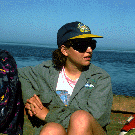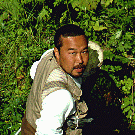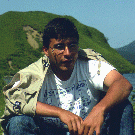
![]()
![]()
1994 NSF Project ReportDEB-9400821, $199,990, 15 July 1994--30 June 1995Biodiversity of the Kuril Archipelago |
| Goals.--The goal of this one-year "proof of concept" award was to examine the feasibility of a collaborative collecting expedition of Russian, Japanese, and American scientists to the southern Kuril Islands: to "fully investigate the need and availability of facilities, collecting possibilities, political and security permits, acceptability of the proposed research vessel, and the commitments of all parties involved." A further requirement was to collect and export a "limited series" of collections that would serve to document that all difficulties had been discovered and successfully negotiated. These goals have been met and, in certain respects, far exceeded. |
 Vladivostok Harbor, home port for the R/V Professor Bogorov.
|
Results to date.--An international team of 23 students and scientists met in Vladivostok on 22 July 1994, boarded the 68.8-m Professor Bogorov, a research vessel of the Russian Academy of Sciences, and spent 31 days in the field. Four of the five major islands of the southern Kurils were visited. Collections were made at 568 sites (186 on Kunashir, 68 on Zelionyi, 62 on Shikotan, and 252 on Iturup) in widely varying habitats, from sea-level sandy-, rocky-beach, and grassland to high-mountain stream/conifer forest; from deep, slow-moving lowland rivers to fast-flowing gravelly streams; and from sphagnum bogs to high mountain lakes. Collecting was confined primarily to four major animal groups: aquatic insects, spiders, freshwater and terrestrial mollusks, and freshwater fishes (small collections of amphipods, butterflies, hemipterans, terrestrial beetles, and amphibians were also made). While we did encounter some difficulties (loss of equipment and supplies through fault of a U.S. airline company; restricted access by Russian military to nature preserves on Kunashir; impenetrable vegetation making adherence to transects impossible; difficult shore landings at some sites; minor equipment breakdown), the serious logistical problems anticipated by some did not materialize: thanks to the work of our Russian counterparts who processed all the many required documents prior to our arrival, passing through Russian customs with 45 pieces of baggage and a $43,000 cash field advance was uneventful; exportation of nearly 30,000 specimens was not questioned. Although permissions to make landings and to collect on the islands were secured well ahead of time from authorities in Moscow, Vladivostok, and Yuzhno-Sakhalinsk, additional required permissions were sought and granted by local governments wherever we went (but, in some cases, not without irritating delays). The research vessel, which served as our base of operations, was well equipped, surprisingly comfortable, and economical: the total cost to NSF, including fuel, food, and partial salaries for the crew and Russian scientists came to less than $40,000 for 42 days (6 days in port, 5 days at sea, and 31 days in the islands).
Research products.--Although counts are still preliminary, approximately 29,600 specimens were successfully exported to the U.S.: Aquatic insects: 5,528 specimens, representing 12 orders and a minimum of 320 species, of which nine (4 plecopterans, 3 trichopterans, 2 ephemeropterans) are thought to be new to science and 82 represent new records for the islands (but 83 lots remain identified only to genus; dipterans, 1,352 specimens, are so far identified only to family). Spiders: 4,640 specimens, 225 species, of which 17-20 are new to science (including two new genera) and at least 40 represent new records for the islands (but seven lots remain identified only to family, 67 remain identified only to genus, and only about 30% of the spiders collected from the two largest islands, Kunashir and Iturup, have been identified to date). Mollusks: 5,920 specimens, at least 58 species, of which 10 are potentially new to science (including two new genera) and at least 12 represent new records for the Archipelago (but many specimens remain identified only to genus). Freshwater fishes: 13,511 specimens, about 18 species, half of which are new records for the islands. The aquatic insects, spiders, and freshwater fishes are presently being identified and cataloged here at the University of Washington; the mollusks are being processed in Jack Burch's lab at the Museum of Zoology, University of Michigan, Ann Arbor. In addition to whole specimens, tissue samples, suitable for future molecular studies, were collected for nearly all taxa, exported to the U.S., and are now maintained at the University of Washington.
|


 Students Suzanne Lindsay, Noboro Minakawa, and Andres Lopez (all UW).
|
Human resource development.--One UW undergraduate, Suzanne Lindsay (mollusks), and two UW graduate students, Noboru Minakawa (insects) and Andres Lopez (fishes), all full participants in the 1994 expedition, received training in field work, curatorial practices, and systematics within their areas of interest. Their experience continues here at home as collections are being sorted and identified, and publications prepared. It is significant that undergraduate Lindsay has turned away from shellfish aquaculture for molluscan systematics; she will spend spring quarter working on the Kuril collections at the University of Michigan, where she has applied to do graduate work with 1994 expedition-veteran Jack Burch. Publications.--Although it is too early to know what will be published, the following is only a small sample of what we expect to produce from this year's field season:
Relation of completed work to the proposed work.--Based on the success of this initial work in the southern Kurils, it is now proposed that the project be expanded to include additional taxa--plants, terrestrial insects, amphibians, reptiles, birds, and mammals--and extended over the next five years to include all the major islands of the Archipelago. |
![]()
 Our efforts are now
directed toward curation, final identification, cataloging specimens, entering
taxonomic information into the computer database, responding to loan
requests, and preparing papers for publication. To expedite particularly
the latter task, most of the remaining budget will be used to offset travel
costs for expedition participants to work with their respective counterparts:
within the next six months, four Russians and two Japanese will visit the
U.S., at least three U.S. participants will spend time in Japan and
Russia, and one U.S. participant, a UW undergraduate student, will go to Ann
Arbor to work with Jack Burch at the University of Michigan.
Our efforts are now
directed toward curation, final identification, cataloging specimens, entering
taxonomic information into the computer database, responding to loan
requests, and preparing papers for publication. To expedite particularly
the latter task, most of the remaining budget will be used to offset travel
costs for expedition participants to work with their respective counterparts:
within the next six months, four Russians and two Japanese will visit the
U.S., at least three U.S. participants will spend time in Japan and
Russia, and one U.S. participant, a UW undergraduate student, will go to Ann
Arbor to work with Jack Burch at the University of Michigan.